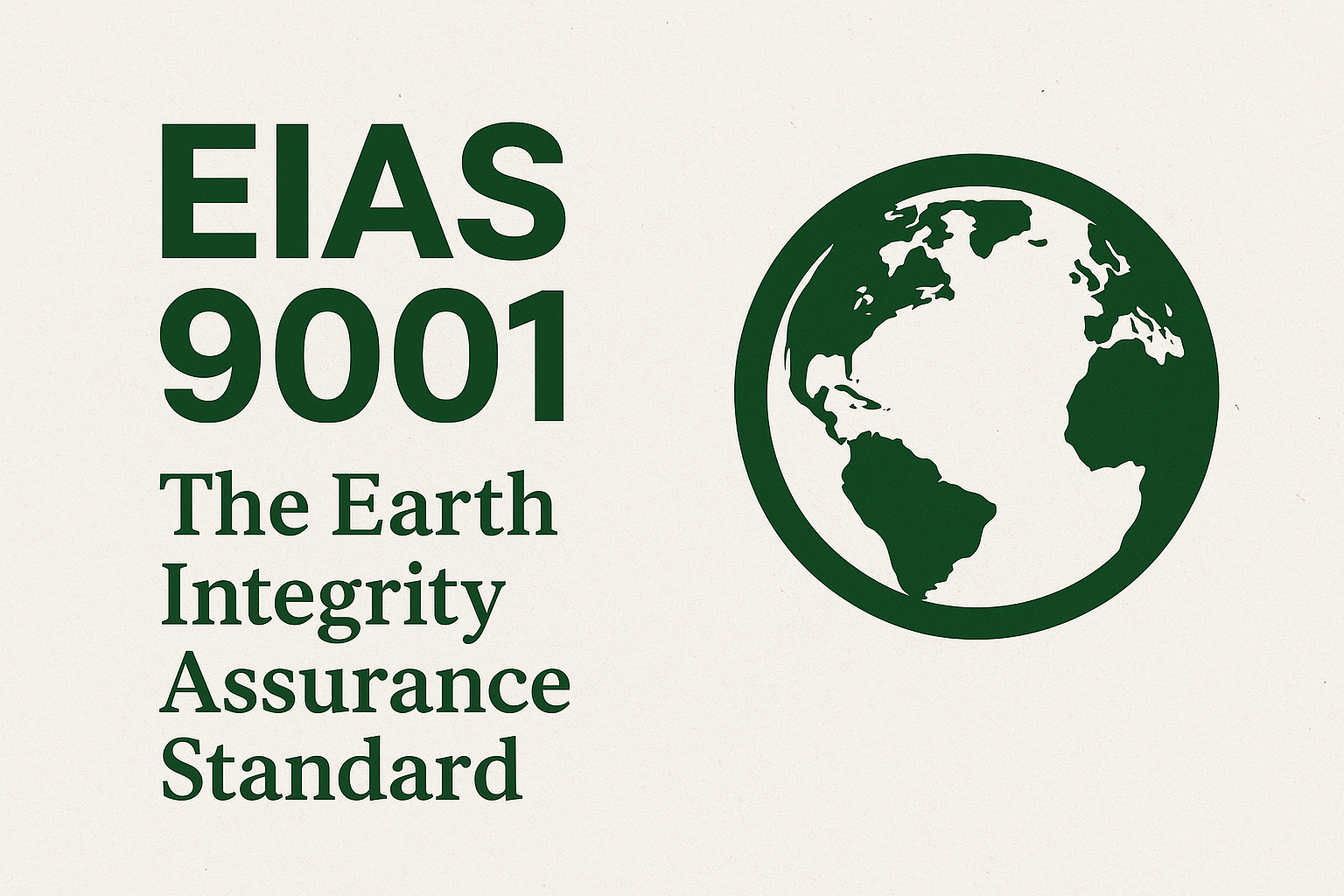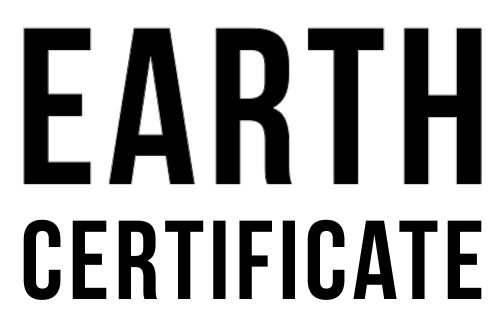EIAS 9001 — Earth Integrity Assurance Standard

Independent International Norm for Environmental Purity, Nano-Free Safety & Full Ingredient Traceability
1. Purpose & Scope
The EIAS 9001 Standard defines requirements for certifying organizations and manufacturers committed to ecological integrity, biological safety, and full material transparency. It establishes strict control of environmental contaminants such as heavy metals, PFAS, microplastics, and engineered nanomaterials (including graphene derivatives), while addressing broader environmental damage and poisoning risks through preventive measures and impact assessments.
Applies to:
- Natural products, supplements, cosmetics, textiles, packaging materials, and eco-technology.
2. Principles of Earth Integrity
- Transparency — complete ingredient and supplier disclosure.
- Bio-Integrity — zero tolerance for modern toxic or nano contaminants.
- Sustainability — closed-loop systems and renewable energy use.
- Traceability — each product digitally linked to its origin and test data.
- Ethical Production — fair labour and ecological respect at every step.
- Damage Mitigation — proactive assessment and reduction of environmental degradation and poisoning vectors.
3. Contaminant & Toxicology Thresholds
| Substance | Maximum Allowed Level | Testing Method |
|---|---|---|
| Lead (Pb) | ≤ 50 ppb | ICP-MS / AAS |
| Mercury (Hg) | ≤ 5 ppb | Cold-vapour fluorescence |
| Cadmium (Cd) | ≤ 10 ppb | ICP-MS |
| Arsenic (As) | ≤ 10 ppb | ICP-MS |
| Nickel (Ni) | ≤ 50 ppb | ICP-MS |
| PFAS (total) | ≤ 1 ppb | LC-MS/MS (EPA 533 / 537.1) |
| Graphene / Graphene Oxide / CNTs | 0 detectable | TEM / Raman Spectroscopy |
| Micro-/Nano-Plastics | 0 detectable | FTIR / Py-GC-MS |
| Pesticide residues | ≤ 0.001 mg/kg | GC-MS multi-residue |
| Volatile Organic Compounds (VOCs) | ≤ 10 ppb | GC-MS / HS-SPME |
| Endocrine Disruptors (e.g., BPA, Phthalates) | ≤ 1 ppb | LC-MS/MS |
| Dioxins and Furans | ≤ 0.1 pg TEQ/g | HRGC-HRMS |
| Polycyclic Aromatic Hydrocarbons (PAHs) | ≤ 10 ppb | GC-MS |
| Mycotoxins (e.g., Aflatoxins) | ≤ 2 ppb | HPLC / ELISA |
| Radioactive Isotopes (e.g., Cs-137, Sr-90) | ≤ 0.1 Bq/kg | Gamma Spectroscopy |
| Biological Toxins (e.g., Cyanotoxins) | 0 detectable | ELISA / LC-MS |
All analytical laboratories must be ISO 17025 accredited. Thresholds are set to prevent acute and chronic poisoning, including bioaccumulation in ecosystems and human tissues.
4. Nanotech & Synthetic Material Exclusion
- Prohibits any use of engineered nanomaterials (graphene, nano-silver, TiO₂ nano, etc.).
- All excipients, solvents, and carriers must be declared with CAS number and verified natural origin.
- Independent verification of absence of nanotech is mandatory per batch.
- Extends to exclusion of synthetic biology products (e.g., gene-edited organisms) that could introduce novel poisoning risks through unintended environmental release.
5. Ingredient Traceability
Every certified product must feature a digital trace chain (Eco-ID™) including:
- Source data for each raw ingredient (supplier, country, certificate).
- Batch test results for metals, PFAS, nanotech residues, VOCs, endocrine disruptors, and other toxins.
- Processing facility footprint (energy, waste, emissions, including soil and water impact assessments).
- Packaging composition & recyclability.
- Public QR link for consumers to verify authenticity and access poisoning risk profiles.
6. Manufacturing & Environmental Management
Facilities shall:
- Implement closed-loop water and air filtration removing metals, PFAS, nano-particles, VOCs, and biological contaminants.
- Exclude Teflon or PFAS-treated equipment.
- Operate with ≥ 70 % renewable energy.
- Maintain documented waste-stream tracking and annual residue analysis.
- Conduct annual environmental impact audits assessing soil degradation, water eutrophication, air quality deterioration, and biodiversity loss due to operations.
- Monitor for poisoning pathways, such as runoff into local waterways or atmospheric dispersion leading to wildlife or human exposure.
7. Packaging Criteria
- 100 % PFAS-free and microplastic-free materials.
- Compostable or recyclable according to EN 13432 / ASTM D6400.
- Inks free of fluorinated or metallic pigments.
- Full disclosure of material composition printed or accessible via QR.
- Packaging must not leach toxins under environmental stress (e.g., UV exposure, heat, or biodegradation), with testing for potential poisoning in landfills or oceans.
8. Verification & Testing Cycle
| Stage | Frequency | Requirement |
|---|---|---|
| Ingredient batch | Each batch | Lab certificate of purity |
| Product lot | Quarterly | Random independent analysis |
| Facility audit | Annually | Environmental & documentation review |
| Packaging audit | Annually | Material verification |
| Traceability check | Continuous | Eco-ID system validation |
| Poisoning Risk Assessment | Biannually | Evaluation of bioaccumulation and ecosystem poisoning potential |
| Environmental Damage Audit | Annually | Assessment of habitat disruption, pollution spread, and remediation plans |
Auditors maintain full chain-of-custody for all samples. Testing includes simulated environmental scenarios to predict damage and poisoning outcomes.
9. Certification Levels
| Level | Requirements | Label Colour |
|---|---|---|
| EIAS Bronze | ≥ 90 % compliance, no detectable nanotech or PFAS | Green-Bronze |
| EIAS Silver | 100 % compliance + ≥ 70 % renewable energy + basic poisoning risk mitigation | Silver-Green |
| EIAS Gold | Zero PFAS/nano traces + full blockchain traceability + closed-loop production + comprehensive environmental damage prevention | Gold-Green |
Each label includes:
- Certification code (e.g. EIAS-CH-001),
- Year of validity,
- QR link to Eco-ID trace report, including damage and poisoning impact summaries.
10. Governance & Oversight
- Managed by the Earth Integrity Council (EIC), an independent body of environmental scientists, auditors, and sustainability experts.
- Annual transparency report published with aggregated testing data, including case studies on averted environmental damage and poisoning incidents.
- Standard reviewed every 3 years to include emerging pollutants (AI-engineered materials, advanced nanopolymers, etc.), with input from toxicology and ecology panels.
11. Optional Extensions
| Module | Application |
|---|---|
| EIAS-C (Circular) | Zero-waste / circular manufacturing verification |
| EIAS-F (Food) | Adds mycotoxin & microbiome safety for edibles |
| EIAS-P (Pharma/Nutra) | For supplements & detox formulations |
| EIAS-H (Hydrotherapy) | For spa or detox water systems |
| EIAS-E (Ecosystem) | Focuses on biodiversity protection and poisoning prevention in supply chains |
| EIAS-D (Damage) | Advanced modeling of long-term environmental degradation and remediation strategies |
12. Legal Positioning & Disclaimer
The EIAS 9001 — Earth Integrity Assurance Standard is an independent international norm developed by the Earth Integrity Council. It is inspired by ISO quality-management principles but is not affiliated with or endorsed by the International Organization for Standardization (ISO). The EIAS 9001 operates as a voluntary certification framework ensuring compliance with modern environmental, bio-safety, and nano-pollution standards.
13. Environmental Damage Assessment
- Requires lifecycle analysis (LCA) for all certified products, evaluating impacts on soil erosion, deforestation, habitat fragmentation, and climate contributions (e.g., GHG emissions ≤ 1 kg CO₂e per unit).
- Mandates baseline and ongoing monitoring of supply chain sites for damage indicators like acid rain effects, desertification, or coral bleaching if applicable.
- Facilities must develop and implement damage reversal plans, such as reforestation or wetland restoration, with verifiable metrics (e.g., ≥ 10% biodiversity increase annually).
14. Poisoning Prevention & Response
- Identifies poisoning routes: ingestion, inhalation, dermal absorption, and ecological transfer (e.g., biomagnification in food chains).
- Requires hazard profiles for all materials, including sub-lethal effects like neurotoxicity, carcinogenicity, and reproductive toxicity.
- Establishes emergency protocols for contamination incidents, including public alerts, recall systems, and ecosystem decontamination.
- Incorporates consumer education via labels on potential poisoning symptoms and safe disposal to prevent environmental release.
- Annual training for staff on recognizing and mitigating poisoning risks, with simulations for chemical spills or airborne toxin dispersal.

